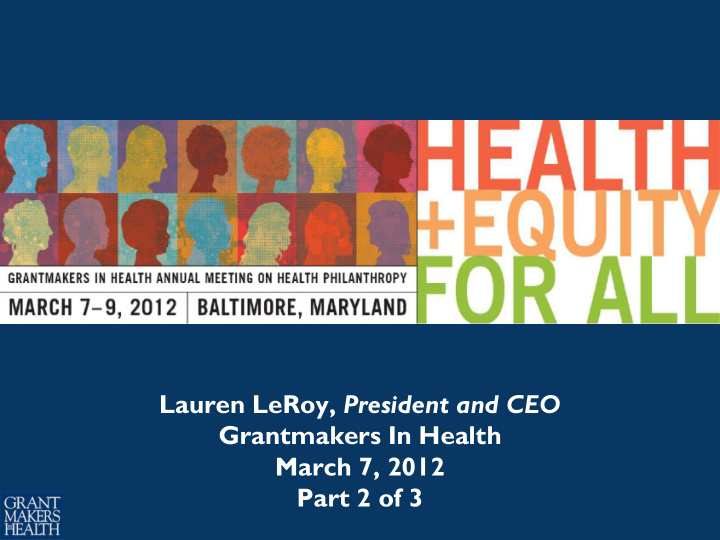



Lauren LeRoy, President and CEO Grantmakers In Health March 7, 2012 Part 2 of 3
Obesity Trends* Am ong U.S. Adults BRFSS, 1 9 9 0 , 2 0 0 0 , 2 0 1 0 ( * BMI ≥ 3 0 , or about 3 0 lbs. overw eight for 5 ’4 ” person) 2 0 0 0 1 9 9 0 2 0 1 0 15%–19% 20%–24% 25%–29% ≥30 % No Data <10% 10%–14% Source: Centers for Disease Control and Prevention
Losses to Public Health Department (PHD) Workforce • Local PHDs: – 29,000: jobs lost from 2008 to 2012 – 31,000: hours reduced or furloughed • State PHDs: – 14,000: jobs lost in 2010 alone – 230,700 furloughed days Sources: Association of State and Territorial Health Officials; The National Association of County and City Health Officials
“Preparedness was on an upward trajectory, but now some of the most elementary capabilities…are experiencing cuts in every state across the country.” Jeff Levi H5N1 Trust for America’s Health
$1 invested in proven community programs yields $5.60 in health care savings Source: Trust for America’s Health
Percentage Living in Poverty, 2011 30.0% 27.4% 26.6% 25.0% 20.0% 15.0% 15.1% 13.0% 10.0% 5.0% 0.0% Total White Black Hispanic Source: U.S. Census Bureau
Census Bureau Supplemental Poverty Measure • 3 million more poor (from 46.3 to 49 million) • Poverty count for seniors up from 9 percent to 15.9 percent • Health care spending had biggest effect on poverty
Percent with Low or Very Low Food Security 16 15 14.6 14.5 14.7 14 13 11.9 11.8 12 11.1 10.9 11 10.5 11.2 11.1 11 10.7 10 10.1 9 1998 1999 2000 2001 2002 2003 2004 2005 2006 2007 2008 2009 2010 Source: U.S. Census Bureau
U.S. Correctional Population, 2009 • 7.2 million adults under correctional supervision • 2.3 million adults in prison Source: U.S. Department of Justice
US Population and Inmates by Race, 2008 Other Other 3% Hispanic 6% Hispanic White 13% 18% 35% Black 12% White Black 69% 44% U.S. Population by Race U.S. Inmates by Race Source: http://filipspagnoli.wordpress.com/stats-on-human-rights/statistics-on-freedon/statistics-on- prisoner-poulation-rates
“While the nation struggles to strengthen the economy, the educational capacity of our country continues to decline.” College Board
U.S. College Graduation Rankings (25 to 34 year olds) Of 34 advanced nations: – 1995: 2 nd – 2010: 12 th Source: Organization for Economic Cooperation and Development
How Do U.S. 15 Year Olds Compare on Reading, Science, and Math? (2009) Out of 34 developed nations: – 14 th Reading – 17 th Science – 25 th Math Source: Organization for Economic Cooperation and Development
“The answer to poverty, most importantly, is good jobs – and to go with that, the education and training that are necessary for all people to be qualified for those jobs.” Peter Edelman Georgetown University Law Center
Source: United Health Foundation, America’s Health Rankings
Healthy People 2010 Progress Cardiovascular Disease Smoking Obesity
Tobacco Consumption Source: Organization for Economic Cooperation and Development
Adult Obesity Rates Source: Organization for Economic Cooperation and Development
Child Obesity Rates Source: Organization for Economic Cooperation and Development
Insurance Coverage Source: Organization for Economic Cooperation and Development
Success Stories • Smoking Prevalence 41 percent (1990 vs 2011) • Violent Crime Rate 34 percent (1990 vs 2011) • Preventable Hospitalizations 21 percent (2001 vs 2011) • Fine Particulates in Air 22 percent (2003 vs 2011) • Infectious Disease Rate 48 percent (1998 vs 2011) • Infant Mortality 33 percent (1990 vs 2011)
HIV/AIDS Patients’ Life Expectancy • 1980s : – Median survival for AIDS patients: 6-8 months • Today (with HIV testing and treatments): – 52.7 additional years for men; 57.8 for women (at age 25, 6 months post-infection) Source: National Institutes of Health
Affordable Care Act Tangible Benefits Since 2010 • Consumer protections: – Elimination of lifetime limits – No coverage recisions – No pre-existing condition exclusions for kids • Coverage for 2.5 million 17-26 year olds • 50,000 high-risk “uninsurables” covered • Millions in new money to CHCs
Medicare • Free preventive services to 75 percent of beneficiaries in 2011 • Part B premium lower in 2012 than 2011 • 2012 Medicare Advantage premiums 16% below 2010 • $3 billion saved for Rx in the “donut hole” coverage gap since 2010
Delivery System Transformation
The ACA and Delivery System Transformation CMMI Initiatives Initiative Total Funding Primary Care Transformation $669.7 million Bundled Payments for Care Improvement $118 million Accountable Care Organizations $254 million Medicare-Medicaid Integration and $15+ million Coordination Capacity to Spread Innovation $1.64 billion Other $175 million Source: Center for Medicare and Medicaid Innovation
Affordable Care Act – Prevention • Prevention and Public Health Fund: $1 billion+ allocated • Preventive services at no cost for 54 million Americans in 2011
National Prevention Strategy
Recommend
More recommend